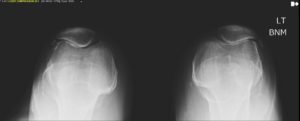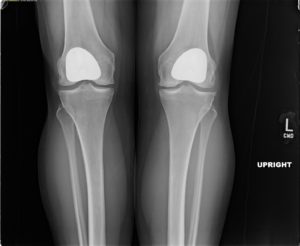The knee is composed of three compartments. The medial(inside) and lateral (outside) compartments bear the body weight when a person is standing. The third compartment is the patellofemoral compartment. This articulation is between the patella (kneecap) and the underlying trochlear groove of the femur. This compartment is critical to activities such as stair climbing and standing up out of a chair. Arthritic change in the patellofemoral compartment can lead to painful crepitus (grinding) in the front of the knee. Stair climbing, squatting, and other activities that involve loading the knee during flexion/extension can become quite painful. Aching in the anterior (front) of the knee is also a common finding associated with this condition.
Most cases of knee osteoarthritis involve all three compartments of the knee. When conservative treatments fail these cases are best treated surgically with total knee replacement. However, in a subset of patients the arthritic changes affects only one area of the knee while sparing the remainder. In these cases partial knee replacement is a viable option. Partial knee replacements allow for the retention of all native knee ligaments as well as less invasive surgery and quicker recovery times. Many patients state that partial knee replacements feel more “natural” than a total knee replacement.
In the case of isolated patellofemoral arthritis the partial knee replacement option is known as Patellofemoral Joint Replacement (Arthroplasty). This surgery involves removing the arthritic bone from the back of the patella and cementing on a prosthetic plastic covering. The femoral trochlear groove where the patella naturally tracks is also treated with a metallic prosthetic resurfacing. This minimally invasive procedure is excellent in treating patients with isolated patellofemoral arthritis and pain limited to the anterior aspect of the knee. This procedure is typically done as a same day surgery with most patients going home the day of surgery. Physical therapy is most often prescribed for postoperative range of motion and strengthening. The majority of patients are back at work within three to four weeks.


